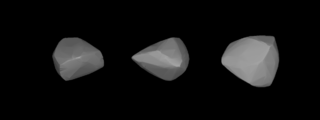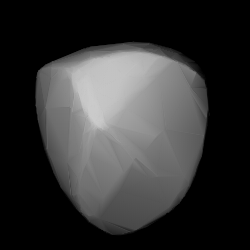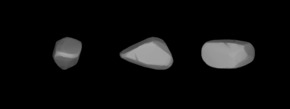460 Scania is a background asteroid and a slow rotator from the central regions of the asteroid belt. It was discovered by German astronomer Max Wolf at the Heidelberg-Königstuhl State Observatory on 22 October 1900. The uncommon K-type asteroid has an exceptionally long rotation period of 164.1 hours and measures approximately 21 kilometers in diameter. It was named after the Swedish region of Scania, where a meeting was held by the Astronomische Gesellschaft in 1904.
478 Tergeste is a rare-type stony asteroid from the outer region of the asteroid belt, approximately 78 kilometers in diameter. It was discovered on 21 September 1901, by Italian astronomer Luigi Carnera at Heidelberg Observatory in southern Germany. It was named after the Italian city of Trieste.
755 Quintilla is a metallic background asteroid from the outer regions of the asteroid belt, approximately 36 kilometers in diameter. It was discovered on 6 April 1908, by American astronomer Joel Metcalf at the Taunton Observatory in Massachusetts, United States. For its size, the M-type asteroid has a relatively short rotation period of 4.55 hours. It was named Quintilla, an Italian female first name, for no reason other than being the first asteroid name beginning with the letter "Q".

771 Libera, provisional designation 1913 TO, is a metallic asteroid from the middle region of the asteroid belt, about 29 kilometers in diameter. It was discovered by Austrian astronomer Joseph Rheden at the Vienna Observatory in Austria, on 21 November 1913.
907 Rhoda is a large background asteroid from the central region of the asteroid belt, that measures approximately 75 kilometers in diameter. It was discovered on 12 November 1918, by astronomer Max Wolf at the Heidelberg Observatory in southwest Germany. The dark C/X-type asteroid has a long rotation period of 22.4 hours and is likely spherical in shape. It was named after Rhoda Barnard, wife of American astronomer Edward Emerson Barnard (1857–1923).
927 Ratisbona is a large and dark background asteroid, approximately 76 kilometers in diameter, located in the outer region of the asteroid belt. It was discovered on 16 February 1920, by astronomer Max Wolf at the Heidelberg Observatory in southwest Germany. The carbonaceous C-type asteroid (CB) has a rotation period of 12.99 hours and is rather spherical in shape. It was named after the Bavarian city of Regensburg.
989 Schwassmannia is a stony background asteroid and a slow rotator from the central regions of the asteroid belt, approximately 12.5 kilometers in diameter. It was discovered on 18 November 1922, by astronomer Friedrich Karl Arnold Schwassmann at the Bergedorf Observatory in Hamburg, Germany. The bright S/T-type asteroid has a long rotation period of 107.9 hours. It was named after the discoverer himself.

994 Otthild is a stony background asteroid from the central regions of the asteroid belt, approximately 24 kilometers in diameter. It was discovered on 18 March 1923, by astronomer Karl Reinmuth at the Heidelberg-Königstuhl State Observatory. The S-type asteroid has a rotation period of 5.95 hours and is rather regular in shape. It was named after a common German female name, unrelated to the discoverer's contemporaries, and taken from the almanac Lahrer Hinkender Bote.

998 Bodea is a dark background asteroid from the outer regions of the asteroid belt, approximately 32 kilometers in diameter. It was discovered on 6 August 1923, by astronomer Karl Reinmuth at the Heidelberg Observatory in southern Germany. The presumed C-type asteroid with an irregular shape has a rotation period of 8.6 hours. It was named after German astronomer Johann Elert Bode (1747–1826).
1994 Shane, provisional designation 1961 TE, is a dark Adeonian asteroid from the central region of the asteroid belt, approximately 25 kilometers in diameter.
Belopolskya, provisional designation 1923 OS, is a dark Cybele asteroid from the outermost region of the asteroid belt, approximately 75 kilometers (47 mi) in diameter. It was named for Russian astrophysicist Aristarkh Belopolsky.
1675 Simonida, provisional designation 1938 FB, is a stony Florian asteroid from the inner regions of the asteroid belt, approximately 11 kilometers in diameter. Discovered by Milorad Protić in 1938, it was later named after the medieval Byzantine princess Simonida.
2697 Albina, provisional designation 1969 TC3, is a carbonaceous asteroid from the outer region of the asteroid belt, approximately 52 kilometers in diameter. It was discovered on 9 October 1969, by Russian astronomer Bella Burnasheva at the Crimean Astrophysical Observatory, Nauchnyj, on the Crimean peninsula. The asteroid was later named after Russian astronomer Albina Serova.
1609 Brenda, provisional designation 1951 NL, is a stony asteroid from the central region of the asteroid belt, approximately 28 kilometers in diameter. It was discovered on 10 July 1951, by South African astronomer Ernest Johnson at the Johannesburg Observatory in South Africa, and named after his granddaughter, Brenda.
3141 Buchar, provisional designation 1984 RH, is a dark Cybele asteroid from the outermost region of the asteroid belt, approximately 36 kilometers in diameter. It was discovered on 2 September 1984, by Czech astronomer Antonín Mrkos at the Kleť Observatory. The D-type asteroid has a rotation period of 11.4 hours. It was named in memory of Czechoslovakian astronomer Emil Buchar.
1817 Katanga, provisional designation 1939 MB, is a stony Phocaea asteroid in from the inner regions of the asteroid belt, approximately 16 kilometers in diameter. It was discovered on 20 June 1939, by English-born South African astronomer Cyril Jackson at Johannesburg Observatory in South Africa. It is named for the Katanga Province.
1255 Schilowa, provisional designation 1932 NC, is a background asteroid from the outer regions of the asteroid belt, approximately 34 kilometers in diameter. It was discovered on 8 July 1932, by Soviet astronomer Grigory Neujmin at the Simeiz Observatory on the Crimean peninsula. The asteroid has a longer-than average rotation period of 29.5 hours. It was named after Mariya Zhilova (Schilowa), who was Russia's first professional female astronomer.
2995 Taratuta, provisional designation 1978 QK, is a stony Eunomian asteroid from the middle region of the asteroid belt, approximately 17 kilometers in diameter. It was discovered on 31 August 1978, by Russian astronomer Nikolai Chernykh at the Crimean Astrophysical Observatory, Nauchnyj, on the Crimean peninsula. The asteroid was later named after Soviet writer Yevgeniya Taratuta.
1585 Union, provisional designation 1947 RG, is a dark background asteroid from the outer regions of the asteroid belt, approximately 52 kilometers in diameter. It was discovered on 7 September 1947, by South African astronomer Ernest Johnson at the Union Observatory in Johannesburg, South Africa. The asteroid was named after the discovering observatory.

1600 Vyssotsky, provisional designation 1947 UC, is a rare-type Hungaria asteroid and suspected interloper from the inner regions of the asteroid belt, approximately 7 kilometers in diameter. It was discovered on 22 October 1947, by American astronomer Carl Wirtanen at Lick Observatory in California, United States. It was named after astronomer Alexander Vyssotsky.




